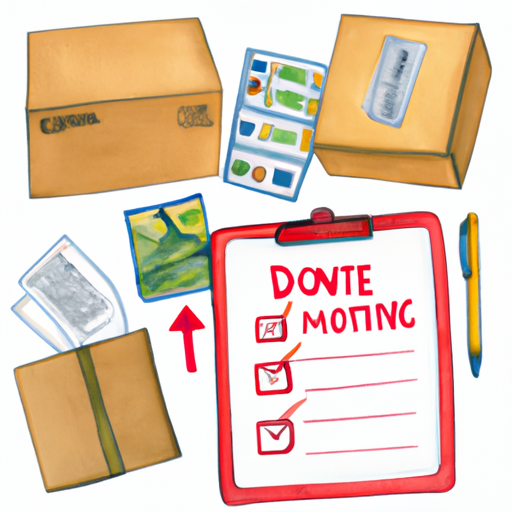This text provides essential steps and tips for a stress-free long-distance move, including starting early, creating checklists, researching moving companies, decluttering, creating a budget, and gathering important documents. It also offers advice on packing and organizing efficiently, as well as tips for an efficient transition to a new home, such as unpacking strategically, organizing the space, familiarizing oneself with the neighborhood, and establishing a routine.
Moving can be a daunting and stressful task, especially when it involves long distances. However, with proper planning, organization, and a few helpful tips, you can make your long-distance move stress-free and efficient. In this article, we will discuss ten essential tips that will guide you through each stage of the moving process. From planning and preparation to packing and organization, and finally settling into your new home, we have you covered. So, let’s dive in and discover how you can make your long-distance move a smooth and hassle-free experience.
- 1. “Planning and Preparation: Essential Steps for a Stress-Free Long-Distance Move”
- 2. “Packing and Organization: Tips to Streamline Your Long-Distance Move”
- 3. “Settling In: Strategies for an Efficient and Hassle-Free Transition to Your New Home”
1. “Planning and Preparation: Essential Steps for a Stress-Free Long-Distance Move”

Planning and Preparation: Essential Steps for a Stress-Free Long-Distance Move
Moving can be an overwhelming experience, especially when it involves a long-distance move. However, with proper planning and preparation, you can make your move stress-free and efficient. Here are some essential steps to consider when planning a long-distance move:
1. Start Early: Time is of the essence when it comes to long-distance moves. Begin planning as soon as you know you’ll be moving. This will give you ample time to organize and execute each step without feeling rushed or overwhelmed.
2. Create a Checklist: A detailed checklist will help you stay organized throughout the moving process. Break down the tasks into smaller, manageable steps, and tick them off as you complete them. This will ensure that you don’t miss anything important and help you stay on track.
3. Research Moving Companies: Long-distance moves often require the assistance of professional moving companies. Take the time to research and compare different options. Read reviews, obtain quotes, and ask for recommendations from friends or family who have previously moved long distances. Choosing a reputable and reliable moving company will give you peace of mind during the entire process.
4. Declutter and Downsize: Moving is the perfect opportunity to declutter your belongings. Before packing, go through each item and determine whether you really need it. Sell, donate, or discard any belongings that no longer serve a purpose in your new home. This will not only reduce the number of items you need to move but also help you start fresh in your new space.
5. Create a Moving Budget: Long-distance moves can be costly, so it’s crucial to create a realistic budget. Consider expenses such as packing supplies, moving company fees, transportation, and temporary accommodation if needed. Having a well-planned budget will help you avoid any financial surprises along the way.
6. Gather Important Documents: Gather all your important documents, such as identification, passports, medical records, and financial papers, in one secure place
2. “Packing and Organization: Tips to Streamline Your Long-Distance Move”

Packing and organization play a crucial role in streamlining a long-distance move. By implementing efficient packing strategies and staying organized throughout the process, you can save time, reduce stress, and ensure that your belongings arrive safely at your new home. Here are some tips to help you pack and organize for a stress-free long-distance move:
1. Start Early: Begin packing well in advance to avoid last-minute rushing. Start with items you rarely use, such as seasonal clothing or decorations. Packing gradually over time allows you to focus on one area at a time, making the process more manageable.
2. Create a Packing Plan: Develop a systematic packing plan, either room by room or by category. This helps you keep track of what has been packed and ensures that items from the same area are kept together, making unpacking easier at your destination.
3. Declutter and Downsize: Moving is an excellent opportunity to declutter and downsize your belongings. Before packing, go through each item and decide whether it’s necessary to bring along. Sell, donate, or discard any items you no longer need or want. Not only does this simplify your move, but it also reduces transportation costs.
4. Gather Packing Supplies: Before you begin packing, ensure you have all the necessary supplies. Stock up on sturdy moving boxes, bubble wrap, packing paper, tape, and markers. Having everything in one place will save you time and prevent unnecessary trips to the store.
5. Use a Labeling System: Clearly label each box with its contents and the room it belongs to. This makes it easier for movers to handle and place the boxes in the appropriate rooms at your new home. Additionally, it aids in locating specific items quickly once you reach your destination.
6. Pack Essentials Separately: Pack a separate box or suitcase with essential items you’ll need immediately upon arrival. This includes toiletries, a change of clothes, important documents, medications, and any valuables. Keep this box with you during the
3. “Settling In: Strategies for an Efficient and Hassle-Free Transition to Your New Home”

Moving to a new home, especially one that is far away, can be a daunting task. However, with the right strategies, you can make the transition to your new home efficient and hassle-free. Here are some tips to help you settle in smoothly:
1. Unpack strategically: When unpacking your belongings, start with the essentials. Unpack the items you use on a daily basis, such as toiletries, kitchenware, and bedding, first. This will ensure that you have everything you need to function comfortably in your new home. Then, gradually unpack the less essential items at your own pace.
2. Organize your space: Take the time to plan and organize the layout of your new home. Determine where each piece of furniture will go and envision how you want each room to function. This will help you avoid unnecessary clutter and create a functional living space. Use labels or color-coded stickers to mark boxes with their respective room, making it easier to unpack and organize efficiently.
3. Familiarize yourself with the neighborhood: Explore your new surroundings and get to know your neighborhood. Locate the nearest grocery stores, pharmacies, hospitals, and other essential services. Research local amenities, such as parks, restaurants, and recreational facilities, to make your transition more enjoyable. This will help you feel more connected to your new community and reduce the stress of adjusting to a new environment.
4. Notify important parties: Ensure a smooth transition by notifying important parties of your change in address. Update your address with the post office, utility companies, financial institutions, and any other organizations or subscriptions that need to have your current information. This will prevent any disruptions in your mail delivery and ensure that all bills and important documents reach you in a timely manner.
5. Establish a routine: Creating a routine in your new home can help you settle in more easily. Establish a schedule for daily activities, such as meal times, exercise, and relaxation. This will provide a sense of normalcy and stability during the
In conclusion, moving long-distance can be a daunting task, but with proper planning, organization, and a positive mindset, it can be a stress-free and efficient experience. By following the tips outlined in this article, such as creating a detailed moving checklist, decluttering before packing, and labeling boxes by room, you can streamline the moving process and ensure a smooth transition to your new home. Additionally, taking the time to research your new area, setting up essential services ahead of time, and creating a comfortable and familiar environment in your new home can help you settle in quickly and hassle-free. Remember, moving is an opportunity for a fresh start, and with the right mindset and preparation, your long-distance move can be a successful and exciting chapter in your life.

